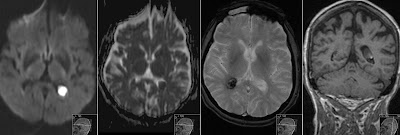Aqueduct Stenosis
44 years old with clinical symptoms indicating hydrocephalus. CT (not shown) confirmed diagnosis of hydrocephalus. However the question was if this was a Normal Pressure Hydrocephalus or Aqueduct Stenosis? MRI performed on 3T using special thin slice T2 (volume) sequences shows increased flow through foramina of Monroe (arrowhead) as well as Magendie with at the same time no visible flow artifacts in the cerebral aqueduct. Further detail inspection of the aqueduct reveals a thin membrane (arrows) that is responsible for the Aqueduct Stenosis. Also note flattened hypophysis due to bulging of the suprasellar cistern. Increased supratentorial ventricles and stretching of corpus callosum. There is also increased flow in the prepontine cistern that might indicate spontaneous connection between floor of the third ventricle and the interpeduncular cistern. Most likely neurosurgical therapy would be to endoscopically create connection at this place (ventriculocisternostomy).



